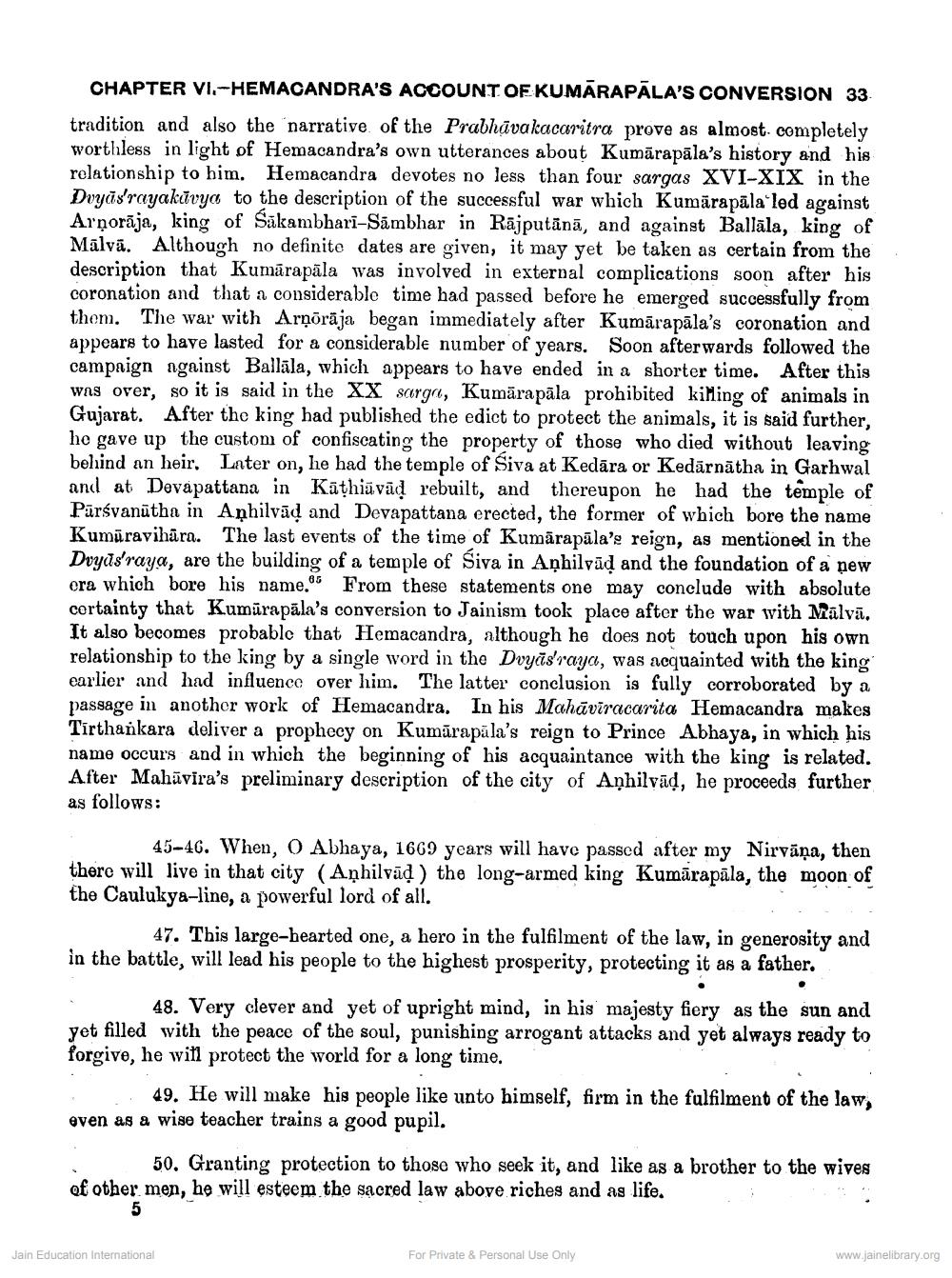________________
CHAPTER VI.-HEMACANDRA'S ACCOUNT OF KUMARAPALA'S CONVERSION 33
tradition and also the narrative of the Prabhāva kacaritra prove as almost completely worthless in light of Hemacandra's own utterances about Kumārapāla's history and his relationship to him. Hemacandra devotes no less than four sargas XVI-XIX in the Dvyās'rayakūvya to the description of the successful war which Kumārapāla led against Arņorāja, king of Sākambhari-Sāmbhar in Rājputānā, and against Ballāla, king of Mālvā. Although no definite dates are given, it may yet be taken as certain from the description that Kumārapāla was involved in external complications soon after his coronation and that a considerable time had passed before he emerged successfully from them. The war with Arņārāja began immediately after Kumārapāla's coronation and appears to have lasted for a considerable number of years. Soon afterwards followed the campaign ngainst Ballāla, which appears to have ended in a shorter time. After this was over, so it is said in the XX sarga, Kumāra pāla prohibited kiming of animals in Gujarat. After the king had published the edict to protect the animals, it is said further, he gave up the custom of confiscating the property of those who died without leaving behind an heir. Later on, he had the temple of Siva at Kedāra or Kedārnātha in Garhwal and at Devapattana in Kathiāvād rebuilt, and thereupon he had the temple of Pārsvanutha in Aņhilvād and Devapattana erected, the former of which bore the name Kumūravihāra. The last events of the time of Kumārapāla's reign, as mentioned in the Dvyūs'raya, are the building of a temple of Siva in Anhilvād and the foundation of a new era which bore his name. From these statements one may conclude with absolute certainty that Kumūrapāla's conversion to Jainism took place after the war with Malvā. It also becomes probable that Hemacandra, although he does not touch upon his own relationship to the king by a single word in the Dvyäsraya, was acquainted with the king earlier and had influence over him. The latter conclusion is fully corroborated by a passage in another work of Hemacandra. In his Mahāviracarita Hemacandra makes Tirthankara deliver a prophecy on Kumārapāla's reign to Prince Abhaya, in which his name occurs and in which the beginning of his acquaintance with the king is related. After Mahüvira's preliminary description of the city of Anhilväd, he proceeds further as follows:
45-46. When, O Abhaya, 1669 years will have passed after my Nirvāņa, then there will live in that city (Aşhilvād ) the long-armed king Kumārapāla, the moon of the Caulukya-line, a powerful lord of all.
47. This large-hearted one, a hero in the fulfilment of the law, in generosity and in the battle, will lead his people to the highest prosperity, protecting it as a father.
48. Very clever and yet of upright mind, in his majesty fiery as the sun and yet filled with the peace of the soul, punishing arrogant attacks and yet always ready to forgive, he will protect the world for a long time.
49. He will make his people like unto himself, firm in the fulfilment of the law, even as a wise teacher trains a good pupil.
50. Granting protection to those who seek it, and like as a brother to the wives of other men, he will esteem the sacred law above riches and as life.
Jain Education International
For Private & Personal Use Only
www.jainelibrary.org




